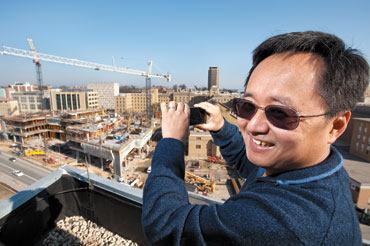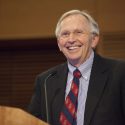For Kim, calculated risk is all in the game
Like many overachievers, Sangtae Kim, who was named last fall to lead the Morgridge Institute for Research, is a calculated taker of risks. He knows chance when he sees it and, importantly, he knows how to size it up.

Sangtae Kim, director of the Morgridge Institute for Research, enjoys a rooftop vantage point to photograph Phase I construction of the Wisconsin Institutes for Discovery. Kim was standing on the roof of the Computer Sciences and Statistics building.
Photo: Jeff Miller
“The thing I remember about the corporate world, especially the (industrial) pharmaceutical world, is high risk-high reward,” says Kim, the former Purdue and Wisconsin engineering professor who was named last fall to lead the Morgridge Institute for Research, the private side of the Wisconsin Institutes for Discovery (WID). “I saw firsthand the enormous risks associated with drug discovery and development. Many projects fail.”
Kim will certainly draw on his experiences with the likes of Eli Lilly, Pfizer and Parke-Davis, where high-rolling on billion-dollar drugs was the stuff of everyday experience. His latest venture, to be sure, is also a game of chance: sculpting a program for a private research institute with aspirations of not just doing groundbreaking research, but doing it on a continuum that transcends discovery by shepherding the fruits of the laboratory to the end point of delivery to the commercial world.
“It’s a high-risk job,” says Carl Gulbrandsen, managing director of the Wisconsin Alumni Research Foundation (WARF), the private, not-for-profit organization that manages intellectual property on behalf of the university. WARF and alumni John and Tashia Morgridge are providing the major private funding that makes the new institute possible. An additional $50 million in state support is directed toward the public half of WID.
“Building something from a blank slate is not an easy task,” Gulbrandsen notes. “But it also is a position of great opportunity. With the risk comes the potential for very high returns.”
Many view Kim, “Sang” to friends and acquaintances, as the perfect pilot for the Morgridge Institute. Amiable and soft-spoken, Kim is known for his energy and intellect, his varied occupational experiences, and vast network of contacts. In short, he seems to have all the leadership qualities required to weave disparate academic undertakings — computational science, engineering and biology — into a seamless research tapestry under the Morgridge banner.
“Universities are filled with really smart people. But every once in a while you encounter someone who is head and shoulders above the rest,” observes UW–Madison engineering physics professor Greg Moses, one of the people who recommended Kim for the job. “He brings together all the different pieces. He walks in all these fields. Any subject you bring up with Sang, he seems to know more about it than anyone else in the room.”
Kim is indeed an accomplished academic. Born in Korea and raised in Canada, he received his bachelor’s and master’s degrees from Caltech simultaneously. After obtaining his doctorate from Princeton in 1983, he began his career at UW–Madison as an assistant professor and climbed the ranks to a named professorship and chair of what is now the department of chemical and biological engineering. As a professor here, Kim became friends with and established closing working ties with former chancellor John Wiley, who at the time was an administrator at the College of Engineering and who is now the interim director of the public Wisconsin Institute for Discovery.
Kim left the university in 1997 to work for major pharmaceutical companies and joined the Purdue faculty in 2003. He is a member of the National Academy of Engineering. His university pedigree gives him the street credentials he’ll need to engage the UW–Madison community in ways that match the sweeping vision of the Morgridge Institute and the larger Wisconsin Institutes for Discovery.
Kim’s experience set is rounded out through an 18-month stint at the National Science Foundation, where he led the charge to transform the agency’s national science and engineering information technology network into an integrated system better suited to the modern scientific enterprise.
“I think we’re fortunate to have him,” says Gulbrandsen. “He has great academic experience. He has government experience. He has worked in industry.”
For now, it is Kim’s academic experience and intimate knowledge of the culture of the big research university — and of Wisconsin’s research landscape in particular — that may serve him best. Morgridge, like its sister institute, the public Wisconsin Institute for Discovery, is intended to be bigger than just a building or a research program. The intent is to make both institutes integral parts of the fabric of the university.
“The biggest challenge in the short term is managing the expectations in the scientific community,” Kim notes. “The institute appearing on the scene as a new opportunity leads to a lot of expectations, and the university and state budgets make for a very challenging environment.”
On the opportunity side of the ledger, says Kim, is the chance to build on an intellectual property model that is the envy of universities everywhere: “Wisconsin and WARF are viewed as the gold standard for technology transfer. We have an opportunity to take something that’s already been successful and take it to a whole new level.”
Art Ellis, a former UW–Madison chemistry professor who is now the vice president for research at the University of California, San Diego, and who worked with Kim at the National Science Foundation, says Kim has the background and moxie to forge a new intellectual model in the Morgridge setting.
“Sang has a deep understanding of intellectual property and technology transfer that will help him bridge the profound differences in academic, government and corporate cultures,” Ellis says.
Kim believes the emerging programmatic structure of Morgridge is the platform that will help the institute, WARF and the university more effectively capitalize on scientific discovery. Now, the plan for Morgridge calls for a central theme of “discovery to delivery.” The discovery platform will be built around two research strengths of UW–Madison, regenerative medicine and virology. The element of delivery, Kim explains, involves a chain of opportunity from the point of discovery to application.
“Throughout the discovery-to-delivery chain, there are multiple research opportunities,” he notes. The notion of using stem cells as crucibles for drug discovery, for instance, is one that could be supported by engineering new nanoscale surfaces for culturing cells, and bioinformatics research to help predict efficacy and safety.
According to Gulbrandsen, Kim’s six-year tour of duty in the pharmaceutical industry lends itself to the research delivery model envisaged for Morgridge: “Between the orphan drug and the billion dollar drug, there are all these unmet needs,” explains Gulbrandsen. “It could be that universities, or philanthropies, or new companies fill that void.”
It may also be filled by new kinds of research institutes, like the Morgridge Institute, which are led by polymaths like Kim.
Observers agree that Kim is smart, energetic and creative, oozing big ideas. But they also note that by nature he is a friendly and charming individual, disarming qualities in the political cauldron of a research university.
“He has a very good manner,” says Gulbrandsen. “He knows how to get where he wants to go without stepping all over you.”


